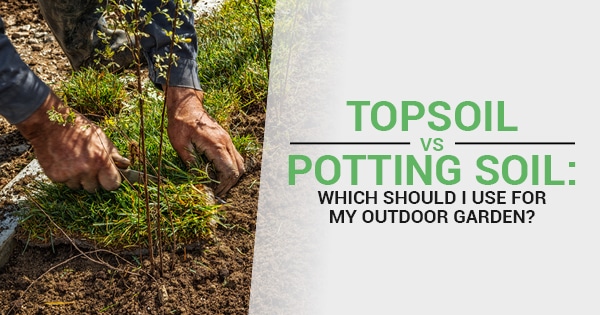Topsoil Vs Potting Soil: Which Should I Use For My Outdoor Garden?
Preparing your yard for a new flowerbed or vegetable garden can be challenging if you’ve never started your own garden before. However, by understanding the right types of soil uses and what to include in your garden, you’ll be guaranteed to have the correct growing conditions for the flowers and plants in your garden.
Gathering the contents of your soil
In terms of soil uses, topsoil is the uppermost layer of a plant’s soil and is approximately two to eight inches thick. What is topsoil made of? There are different types of topsoil, but it can best be described as a mixture of soil and materials such as sand, manure, and wood fines.
Potting soil is mostly made up of perlite, aged compost, peat, and vermiculite. It’s typically described as the soil used in gardening that helps plants and flowers to retain nutrients and water. Potting soil is also used to help prevent compaction, which can prevent plants from filtering out carbon dioxide and other toxic gasses that can kill the roots.
Different plants thrive in different types of soil uses and so it’s important to know the differences between topsoil and potting soil before you begin using random soils, drainage gravel, and rockery rocks in your landscaping.
Topsoil vs Potting Soil
The ingredients in potting soil are more specific to your intended growing environment because its contents are more consistent than topsoil. Topsoil has a wider range of materials because its contents are taken from the top of a field, meaning it isn’t as sterile as potting soil.
However, while potting soil may not contain weed seeds like topsoil might, it often doesn’t contain any real soil either. This is often why potting soil is referred to as soil-less.
Potting soil is best used for when your plants are still in containers. When combined with soil outdoors it can cause the soil in your garden to dry out because it can often drain too well.
Topsoil on the other hand is best combined with outdoor soil that already exists in your garden or flowerbed. However, if your plants are in containers it may be a better idea to use potting soil. This is because topsoil can sometimes be too moist for container gardens, which can cause root rot.
Getting the best results
In order to encourage growth in your outdoor garden, add anywhere between 2 to 3 inches of topsoil to your garden and mix the topsoil with the existing soil without covering the plants. Mixing the topsoil gives your plants time to adapt and also helps to create a transitional soil layer. However, it should be noted that topsoil isn’t fertilizer and can’t give your plants all the necessary nutrients they need.
There are different soil uses for every garden, which is really what makes gardening for the first time feel difficult. However, with the right soil and the right questions, you can encourage the best growth possible in your outdoor garden.

